Reflection Report: Key Learnings from the Leadership Module
VerifiedAdded on 2022/11/24
|13
|5102
|425
Report
AI Summary
This report presents a student's reflection on a leadership module, focusing on key concepts such as task, career, and extramural interests, the nature and exercise of power, and different approaches to power dynamics within organizations. The reflection explores the significance of shared mindsets, conflict resolution, and the impact of trade unions. It delves into the theories of Karl Marx and Max Weber on production relations and power. Furthermore, the report examines sensemaking processes, change management strategies, and the challenges of resistance to change, including the importance of effective communication and employee engagement. It highlights the qualities of charismatic leaders, emphasizing communication, humility, confidence, and listening skills. The reflection concludes by discussing strategies to overcome resistance to change, focusing on communication, employee engagement, and feedback mechanisms.
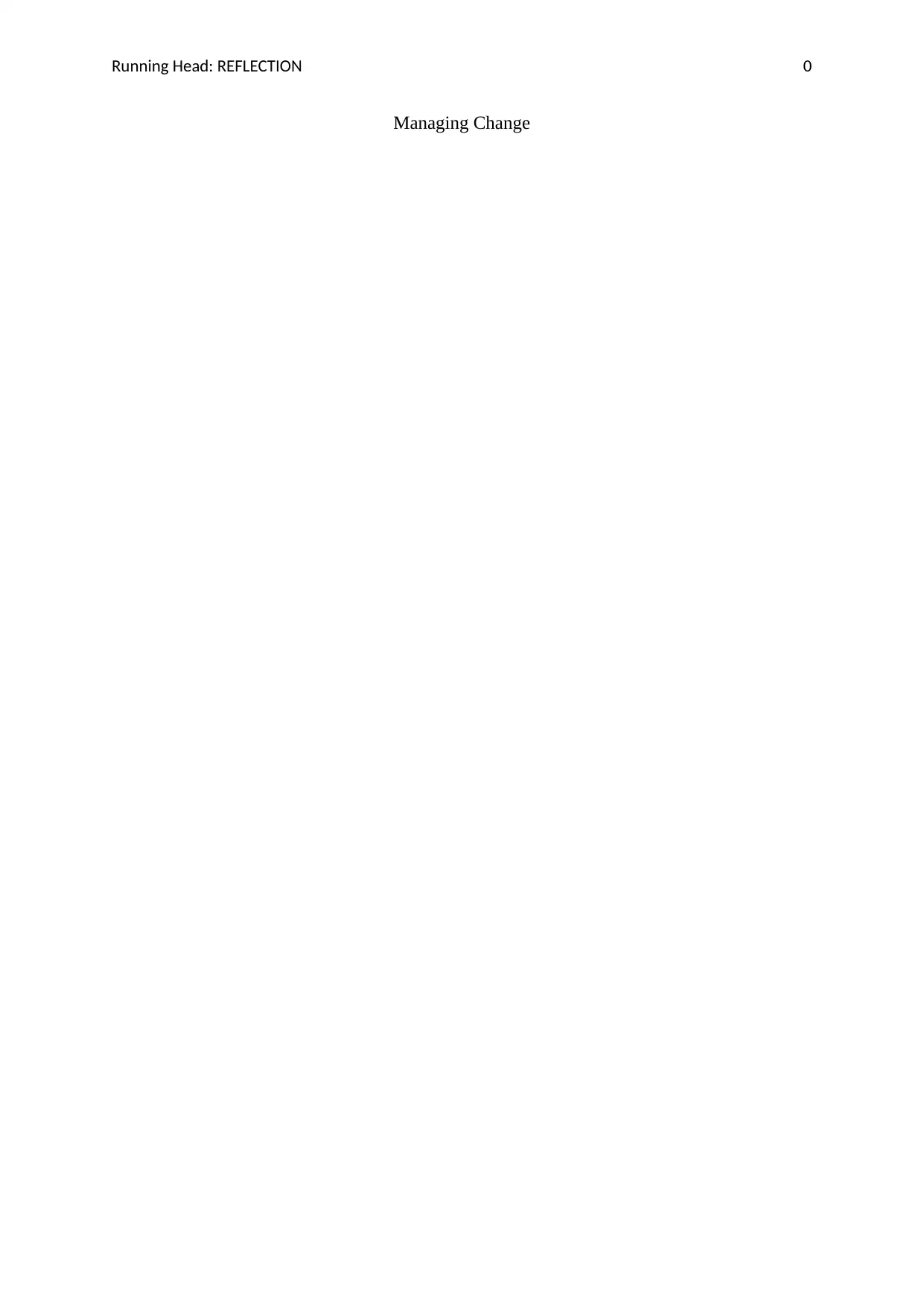
Running Head: REFLECTION 0
Managing Change
Managing Change
Paraphrase This Document
Need a fresh take? Get an instant paraphrase of this document with our AI Paraphraser
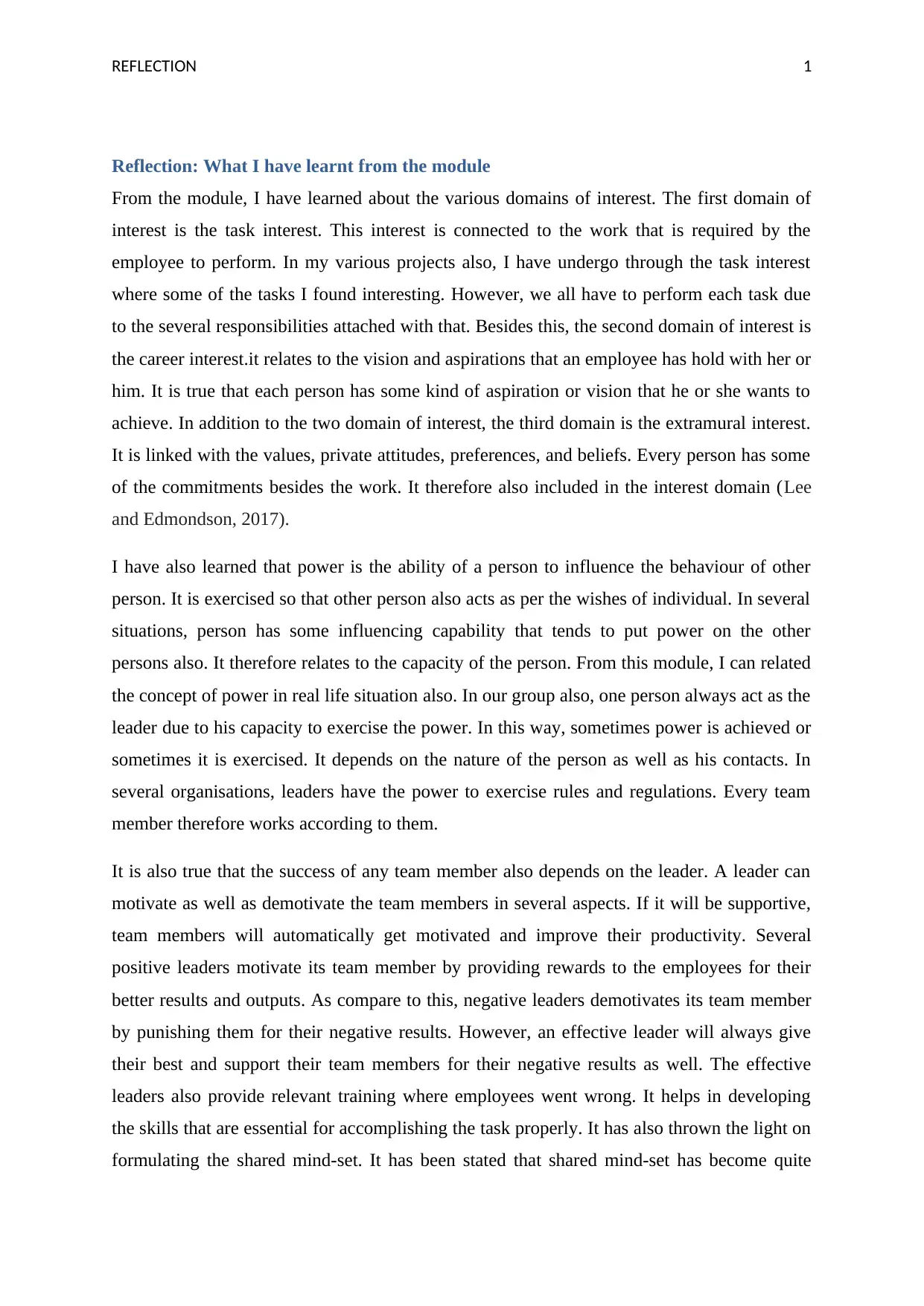
REFLECTION 1
Reflection: What I have learnt from the module
From the module, I have learned about the various domains of interest. The first domain of
interest is the task interest. This interest is connected to the work that is required by the
employee to perform. In my various projects also, I have undergo through the task interest
where some of the tasks I found interesting. However, we all have to perform each task due
to the several responsibilities attached with that. Besides this, the second domain of interest is
the career interest.it relates to the vision and aspirations that an employee has hold with her or
him. It is true that each person has some kind of aspiration or vision that he or she wants to
achieve. In addition to the two domain of interest, the third domain is the extramural interest.
It is linked with the values, private attitudes, preferences, and beliefs. Every person has some
of the commitments besides the work. It therefore also included in the interest domain (Lee
and Edmondson, 2017).
I have also learned that power is the ability of a person to influence the behaviour of other
person. It is exercised so that other person also acts as per the wishes of individual. In several
situations, person has some influencing capability that tends to put power on the other
persons also. It therefore relates to the capacity of the person. From this module, I can related
the concept of power in real life situation also. In our group also, one person always act as the
leader due to his capacity to exercise the power. In this way, sometimes power is achieved or
sometimes it is exercised. It depends on the nature of the person as well as his contacts. In
several organisations, leaders have the power to exercise rules and regulations. Every team
member therefore works according to them.
It is also true that the success of any team member also depends on the leader. A leader can
motivate as well as demotivate the team members in several aspects. If it will be supportive,
team members will automatically get motivated and improve their productivity. Several
positive leaders motivate its team member by providing rewards to the employees for their
better results and outputs. As compare to this, negative leaders demotivates its team member
by punishing them for their negative results. However, an effective leader will always give
their best and support their team members for their negative results as well. The effective
leaders also provide relevant training where employees went wrong. It helps in developing
the skills that are essential for accomplishing the task properly. It has also thrown the light on
formulating the shared mind-set. It has been stated that shared mind-set has become quite
Reflection: What I have learnt from the module
From the module, I have learned about the various domains of interest. The first domain of
interest is the task interest. This interest is connected to the work that is required by the
employee to perform. In my various projects also, I have undergo through the task interest
where some of the tasks I found interesting. However, we all have to perform each task due
to the several responsibilities attached with that. Besides this, the second domain of interest is
the career interest.it relates to the vision and aspirations that an employee has hold with her or
him. It is true that each person has some kind of aspiration or vision that he or she wants to
achieve. In addition to the two domain of interest, the third domain is the extramural interest.
It is linked with the values, private attitudes, preferences, and beliefs. Every person has some
of the commitments besides the work. It therefore also included in the interest domain (Lee
and Edmondson, 2017).
I have also learned that power is the ability of a person to influence the behaviour of other
person. It is exercised so that other person also acts as per the wishes of individual. In several
situations, person has some influencing capability that tends to put power on the other
persons also. It therefore relates to the capacity of the person. From this module, I can related
the concept of power in real life situation also. In our group also, one person always act as the
leader due to his capacity to exercise the power. In this way, sometimes power is achieved or
sometimes it is exercised. It depends on the nature of the person as well as his contacts. In
several organisations, leaders have the power to exercise rules and regulations. Every team
member therefore works according to them.
It is also true that the success of any team member also depends on the leader. A leader can
motivate as well as demotivate the team members in several aspects. If it will be supportive,
team members will automatically get motivated and improve their productivity. Several
positive leaders motivate its team member by providing rewards to the employees for their
better results and outputs. As compare to this, negative leaders demotivates its team member
by punishing them for their negative results. However, an effective leader will always give
their best and support their team members for their negative results as well. The effective
leaders also provide relevant training where employees went wrong. It helps in developing
the skills that are essential for accomplishing the task properly. It has also thrown the light on
formulating the shared mind-set. It has been stated that shared mind-set has become quite
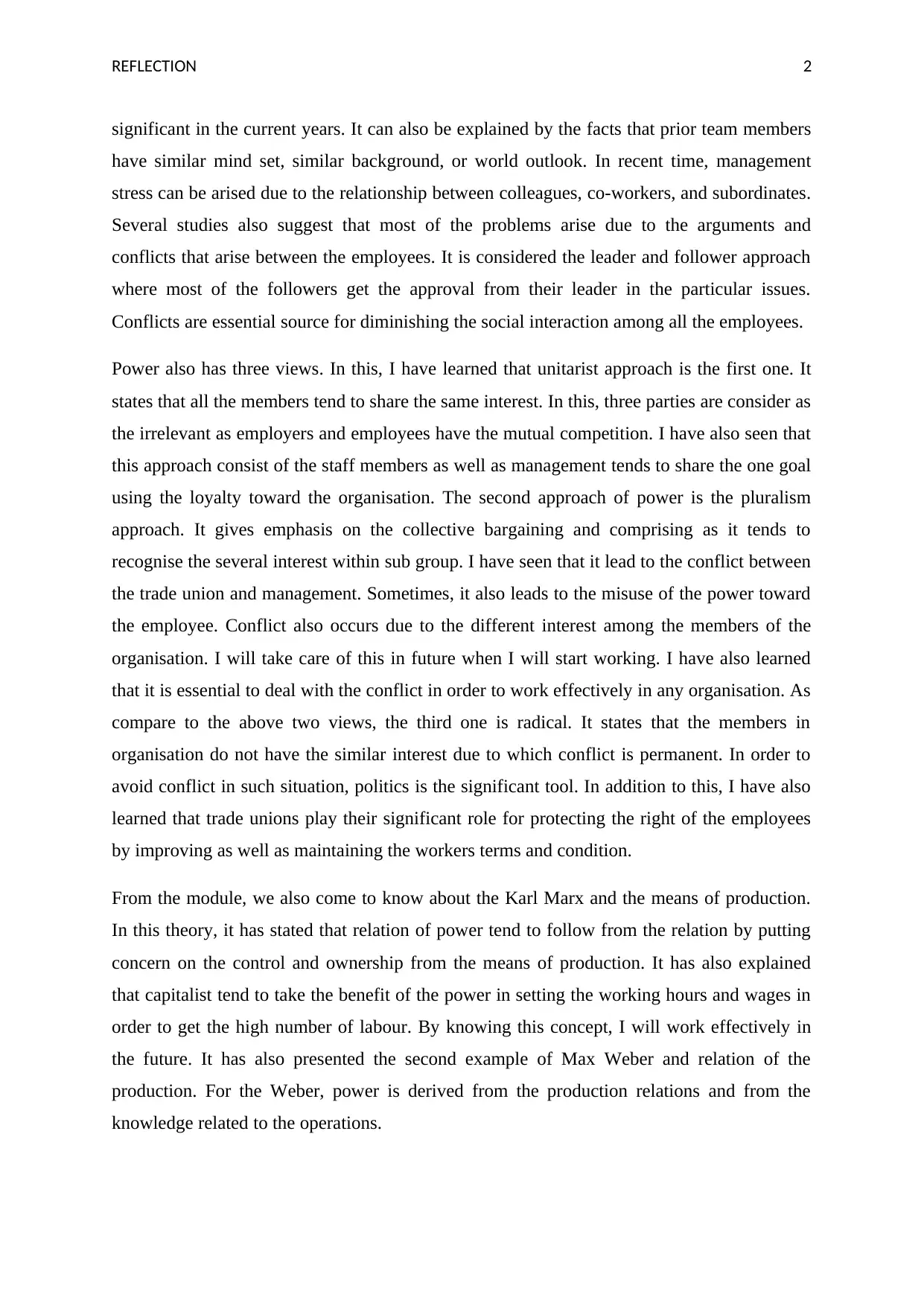
REFLECTION 2
significant in the current years. It can also be explained by the facts that prior team members
have similar mind set, similar background, or world outlook. In recent time, management
stress can be arised due to the relationship between colleagues, co-workers, and subordinates.
Several studies also suggest that most of the problems arise due to the arguments and
conflicts that arise between the employees. It is considered the leader and follower approach
where most of the followers get the approval from their leader in the particular issues.
Conflicts are essential source for diminishing the social interaction among all the employees.
Power also has three views. In this, I have learned that unitarist approach is the first one. It
states that all the members tend to share the same interest. In this, three parties are consider as
the irrelevant as employers and employees have the mutual competition. I have also seen that
this approach consist of the staff members as well as management tends to share the one goal
using the loyalty toward the organisation. The second approach of power is the pluralism
approach. It gives emphasis on the collective bargaining and comprising as it tends to
recognise the several interest within sub group. I have seen that it lead to the conflict between
the trade union and management. Sometimes, it also leads to the misuse of the power toward
the employee. Conflict also occurs due to the different interest among the members of the
organisation. I will take care of this in future when I will start working. I have also learned
that it is essential to deal with the conflict in order to work effectively in any organisation. As
compare to the above two views, the third one is radical. It states that the members in
organisation do not have the similar interest due to which conflict is permanent. In order to
avoid conflict in such situation, politics is the significant tool. In addition to this, I have also
learned that trade unions play their significant role for protecting the right of the employees
by improving as well as maintaining the workers terms and condition.
From the module, we also come to know about the Karl Marx and the means of production.
In this theory, it has stated that relation of power tend to follow from the relation by putting
concern on the control and ownership from the means of production. It has also explained
that capitalist tend to take the benefit of the power in setting the working hours and wages in
order to get the high number of labour. By knowing this concept, I will work effectively in
the future. It has also presented the second example of Max Weber and relation of the
production. For the Weber, power is derived from the production relations and from the
knowledge related to the operations.
significant in the current years. It can also be explained by the facts that prior team members
have similar mind set, similar background, or world outlook. In recent time, management
stress can be arised due to the relationship between colleagues, co-workers, and subordinates.
Several studies also suggest that most of the problems arise due to the arguments and
conflicts that arise between the employees. It is considered the leader and follower approach
where most of the followers get the approval from their leader in the particular issues.
Conflicts are essential source for diminishing the social interaction among all the employees.
Power also has three views. In this, I have learned that unitarist approach is the first one. It
states that all the members tend to share the same interest. In this, three parties are consider as
the irrelevant as employers and employees have the mutual competition. I have also seen that
this approach consist of the staff members as well as management tends to share the one goal
using the loyalty toward the organisation. The second approach of power is the pluralism
approach. It gives emphasis on the collective bargaining and comprising as it tends to
recognise the several interest within sub group. I have seen that it lead to the conflict between
the trade union and management. Sometimes, it also leads to the misuse of the power toward
the employee. Conflict also occurs due to the different interest among the members of the
organisation. I will take care of this in future when I will start working. I have also learned
that it is essential to deal with the conflict in order to work effectively in any organisation. As
compare to the above two views, the third one is radical. It states that the members in
organisation do not have the similar interest due to which conflict is permanent. In order to
avoid conflict in such situation, politics is the significant tool. In addition to this, I have also
learned that trade unions play their significant role for protecting the right of the employees
by improving as well as maintaining the workers terms and condition.
From the module, we also come to know about the Karl Marx and the means of production.
In this theory, it has stated that relation of power tend to follow from the relation by putting
concern on the control and ownership from the means of production. It has also explained
that capitalist tend to take the benefit of the power in setting the working hours and wages in
order to get the high number of labour. By knowing this concept, I will work effectively in
the future. It has also presented the second example of Max Weber and relation of the
production. For the Weber, power is derived from the production relations and from the
knowledge related to the operations.
⊘ This is a preview!⊘
Do you want full access?
Subscribe today to unlock all pages.

Trusted by 1+ million students worldwide
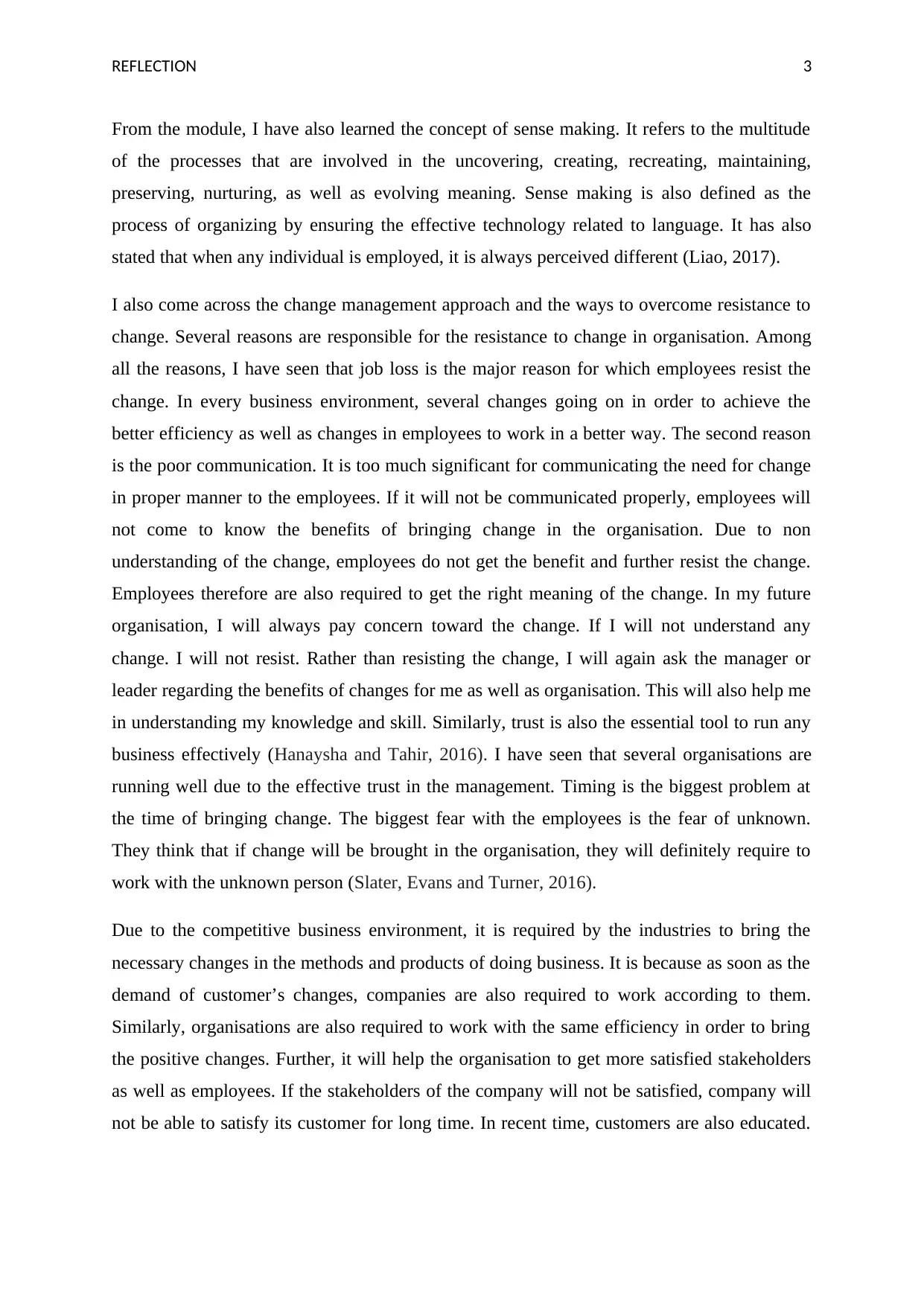
REFLECTION 3
From the module, I have also learned the concept of sense making. It refers to the multitude
of the processes that are involved in the uncovering, creating, recreating, maintaining,
preserving, nurturing, as well as evolving meaning. Sense making is also defined as the
process of organizing by ensuring the effective technology related to language. It has also
stated that when any individual is employed, it is always perceived different (Liao, 2017).
I also come across the change management approach and the ways to overcome resistance to
change. Several reasons are responsible for the resistance to change in organisation. Among
all the reasons, I have seen that job loss is the major reason for which employees resist the
change. In every business environment, several changes going on in order to achieve the
better efficiency as well as changes in employees to work in a better way. The second reason
is the poor communication. It is too much significant for communicating the need for change
in proper manner to the employees. If it will not be communicated properly, employees will
not come to know the benefits of bringing change in the organisation. Due to non
understanding of the change, employees do not get the benefit and further resist the change.
Employees therefore are also required to get the right meaning of the change. In my future
organisation, I will always pay concern toward the change. If I will not understand any
change. I will not resist. Rather than resisting the change, I will again ask the manager or
leader regarding the benefits of changes for me as well as organisation. This will also help me
in understanding my knowledge and skill. Similarly, trust is also the essential tool to run any
business effectively (Hanaysha and Tahir, 2016). I have seen that several organisations are
running well due to the effective trust in the management. Timing is the biggest problem at
the time of bringing change. The biggest fear with the employees is the fear of unknown.
They think that if change will be brought in the organisation, they will definitely require to
work with the unknown person (Slater, Evans and Turner, 2016).
Due to the competitive business environment, it is required by the industries to bring the
necessary changes in the methods and products of doing business. It is because as soon as the
demand of customer’s changes, companies are also required to work according to them.
Similarly, organisations are also required to work with the same efficiency in order to bring
the positive changes. Further, it will help the organisation to get more satisfied stakeholders
as well as employees. If the stakeholders of the company will not be satisfied, company will
not be able to satisfy its customer for long time. In recent time, customers are also educated.
From the module, I have also learned the concept of sense making. It refers to the multitude
of the processes that are involved in the uncovering, creating, recreating, maintaining,
preserving, nurturing, as well as evolving meaning. Sense making is also defined as the
process of organizing by ensuring the effective technology related to language. It has also
stated that when any individual is employed, it is always perceived different (Liao, 2017).
I also come across the change management approach and the ways to overcome resistance to
change. Several reasons are responsible for the resistance to change in organisation. Among
all the reasons, I have seen that job loss is the major reason for which employees resist the
change. In every business environment, several changes going on in order to achieve the
better efficiency as well as changes in employees to work in a better way. The second reason
is the poor communication. It is too much significant for communicating the need for change
in proper manner to the employees. If it will not be communicated properly, employees will
not come to know the benefits of bringing change in the organisation. Due to non
understanding of the change, employees do not get the benefit and further resist the change.
Employees therefore are also required to get the right meaning of the change. In my future
organisation, I will always pay concern toward the change. If I will not understand any
change. I will not resist. Rather than resisting the change, I will again ask the manager or
leader regarding the benefits of changes for me as well as organisation. This will also help me
in understanding my knowledge and skill. Similarly, trust is also the essential tool to run any
business effectively (Hanaysha and Tahir, 2016). I have seen that several organisations are
running well due to the effective trust in the management. Timing is the biggest problem at
the time of bringing change. The biggest fear with the employees is the fear of unknown.
They think that if change will be brought in the organisation, they will definitely require to
work with the unknown person (Slater, Evans and Turner, 2016).
Due to the competitive business environment, it is required by the industries to bring the
necessary changes in the methods and products of doing business. It is because as soon as the
demand of customer’s changes, companies are also required to work according to them.
Similarly, organisations are also required to work with the same efficiency in order to bring
the positive changes. Further, it will help the organisation to get more satisfied stakeholders
as well as employees. If the stakeholders of the company will not be satisfied, company will
not be able to satisfy its customer for long time. In recent time, customers are also educated.
Paraphrase This Document
Need a fresh take? Get an instant paraphrase of this document with our AI Paraphraser
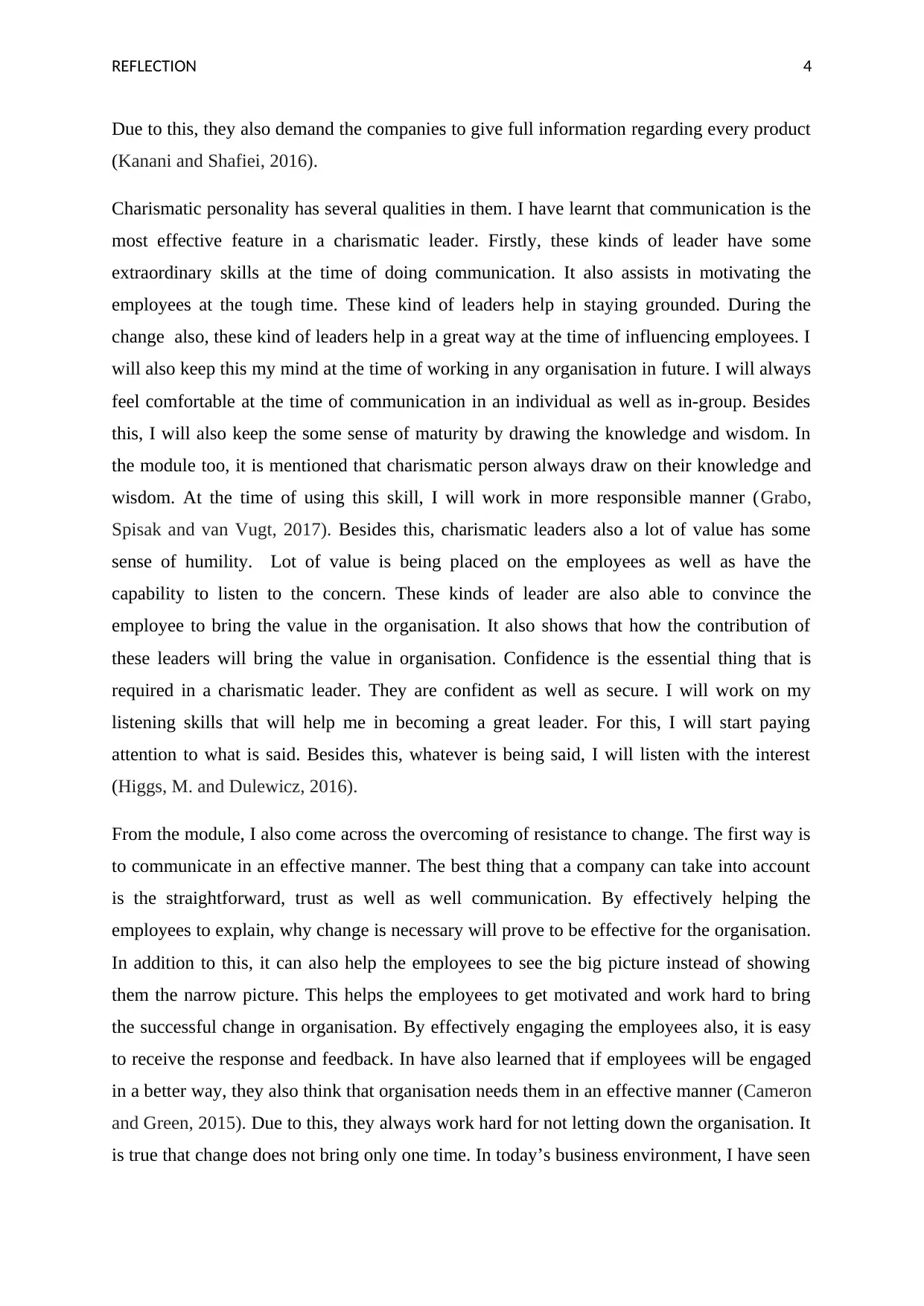
REFLECTION 4
Due to this, they also demand the companies to give full information regarding every product
(Kanani and Shafiei, 2016).
Charismatic personality has several qualities in them. I have learnt that communication is the
most effective feature in a charismatic leader. Firstly, these kinds of leader have some
extraordinary skills at the time of doing communication. It also assists in motivating the
employees at the tough time. These kind of leaders help in staying grounded. During the
change also, these kind of leaders help in a great way at the time of influencing employees. I
will also keep this my mind at the time of working in any organisation in future. I will always
feel comfortable at the time of communication in an individual as well as in-group. Besides
this, I will also keep the some sense of maturity by drawing the knowledge and wisdom. In
the module too, it is mentioned that charismatic person always draw on their knowledge and
wisdom. At the time of using this skill, I will work in more responsible manner (Grabo,
Spisak and van Vugt, 2017). Besides this, charismatic leaders also a lot of value has some
sense of humility. Lot of value is being placed on the employees as well as have the
capability to listen to the concern. These kinds of leader are also able to convince the
employee to bring the value in the organisation. It also shows that how the contribution of
these leaders will bring the value in organisation. Confidence is the essential thing that is
required in a charismatic leader. They are confident as well as secure. I will work on my
listening skills that will help me in becoming a great leader. For this, I will start paying
attention to what is said. Besides this, whatever is being said, I will listen with the interest
(Higgs, M. and Dulewicz, 2016).
From the module, I also come across the overcoming of resistance to change. The first way is
to communicate in an effective manner. The best thing that a company can take into account
is the straightforward, trust as well as well communication. By effectively helping the
employees to explain, why change is necessary will prove to be effective for the organisation.
In addition to this, it can also help the employees to see the big picture instead of showing
them the narrow picture. This helps the employees to get motivated and work hard to bring
the successful change in organisation. By effectively engaging the employees also, it is easy
to receive the response and feedback. In have also learned that if employees will be engaged
in a better way, they also think that organisation needs them in an effective manner (Cameron
and Green, 2015). Due to this, they always work hard for not letting down the organisation. It
is true that change does not bring only one time. In today’s business environment, I have seen
Due to this, they also demand the companies to give full information regarding every product
(Kanani and Shafiei, 2016).
Charismatic personality has several qualities in them. I have learnt that communication is the
most effective feature in a charismatic leader. Firstly, these kinds of leader have some
extraordinary skills at the time of doing communication. It also assists in motivating the
employees at the tough time. These kind of leaders help in staying grounded. During the
change also, these kind of leaders help in a great way at the time of influencing employees. I
will also keep this my mind at the time of working in any organisation in future. I will always
feel comfortable at the time of communication in an individual as well as in-group. Besides
this, I will also keep the some sense of maturity by drawing the knowledge and wisdom. In
the module too, it is mentioned that charismatic person always draw on their knowledge and
wisdom. At the time of using this skill, I will work in more responsible manner (Grabo,
Spisak and van Vugt, 2017). Besides this, charismatic leaders also a lot of value has some
sense of humility. Lot of value is being placed on the employees as well as have the
capability to listen to the concern. These kinds of leader are also able to convince the
employee to bring the value in the organisation. It also shows that how the contribution of
these leaders will bring the value in organisation. Confidence is the essential thing that is
required in a charismatic leader. They are confident as well as secure. I will work on my
listening skills that will help me in becoming a great leader. For this, I will start paying
attention to what is said. Besides this, whatever is being said, I will listen with the interest
(Higgs, M. and Dulewicz, 2016).
From the module, I also come across the overcoming of resistance to change. The first way is
to communicate in an effective manner. The best thing that a company can take into account
is the straightforward, trust as well as well communication. By effectively helping the
employees to explain, why change is necessary will prove to be effective for the organisation.
In addition to this, it can also help the employees to see the big picture instead of showing
them the narrow picture. This helps the employees to get motivated and work hard to bring
the successful change in organisation. By effectively engaging the employees also, it is easy
to receive the response and feedback. In have also learned that if employees will be engaged
in a better way, they also think that organisation needs them in an effective manner (Cameron
and Green, 2015). Due to this, they always work hard for not letting down the organisation. It
is true that change does not bring only one time. In today’s business environment, I have seen
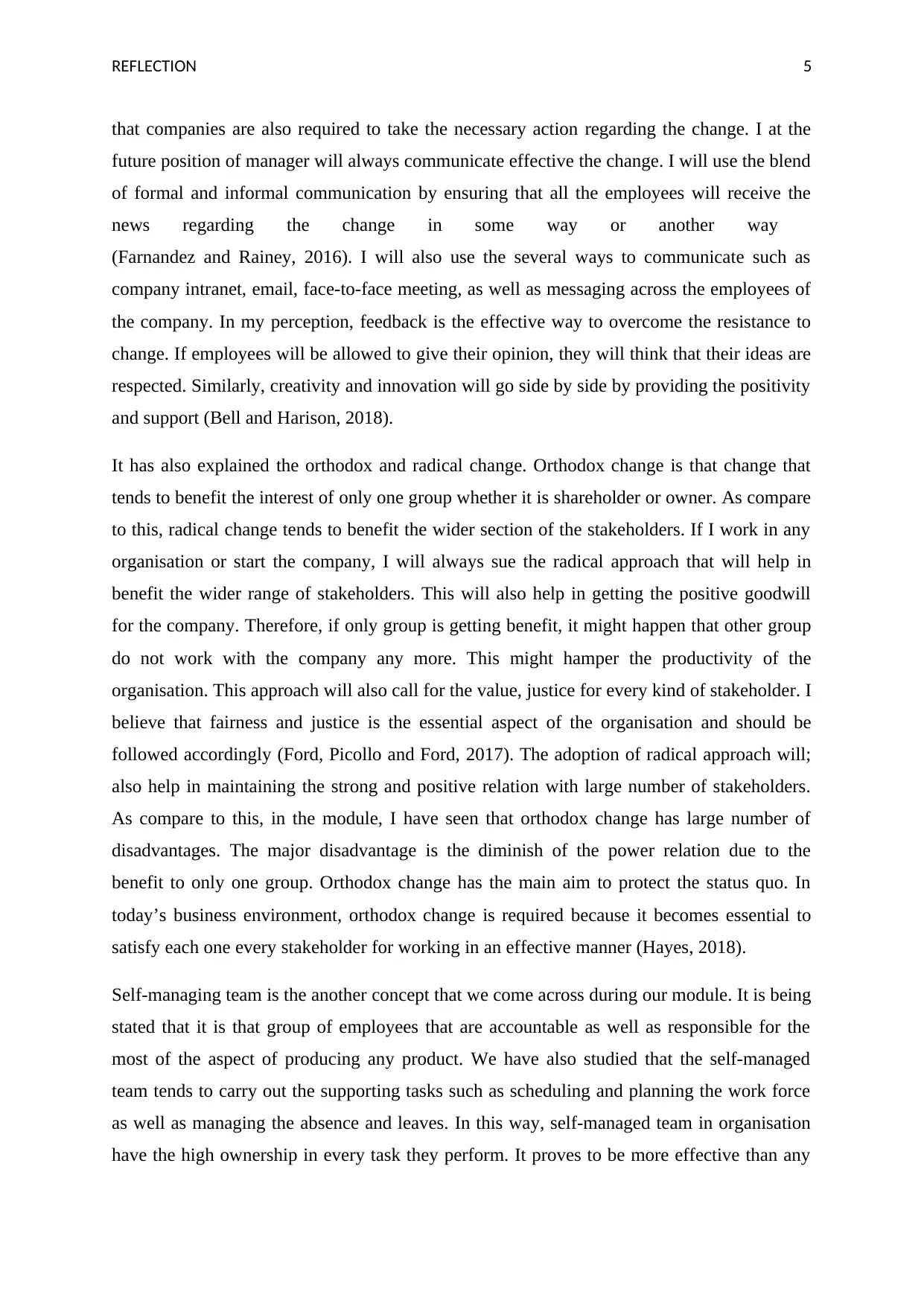
REFLECTION 5
that companies are also required to take the necessary action regarding the change. I at the
future position of manager will always communicate effective the change. I will use the blend
of formal and informal communication by ensuring that all the employees will receive the
news regarding the change in some way or another way
(Farnandez and Rainey, 2016). I will also use the several ways to communicate such as
company intranet, email, face-to-face meeting, as well as messaging across the employees of
the company. In my perception, feedback is the effective way to overcome the resistance to
change. If employees will be allowed to give their opinion, they will think that their ideas are
respected. Similarly, creativity and innovation will go side by side by providing the positivity
and support (Bell and Harison, 2018).
It has also explained the orthodox and radical change. Orthodox change is that change that
tends to benefit the interest of only one group whether it is shareholder or owner. As compare
to this, radical change tends to benefit the wider section of the stakeholders. If I work in any
organisation or start the company, I will always sue the radical approach that will help in
benefit the wider range of stakeholders. This will also help in getting the positive goodwill
for the company. Therefore, if only group is getting benefit, it might happen that other group
do not work with the company any more. This might hamper the productivity of the
organisation. This approach will also call for the value, justice for every kind of stakeholder. I
believe that fairness and justice is the essential aspect of the organisation and should be
followed accordingly (Ford, Picollo and Ford, 2017). The adoption of radical approach will;
also help in maintaining the strong and positive relation with large number of stakeholders.
As compare to this, in the module, I have seen that orthodox change has large number of
disadvantages. The major disadvantage is the diminish of the power relation due to the
benefit to only one group. Orthodox change has the main aim to protect the status quo. In
today’s business environment, orthodox change is required because it becomes essential to
satisfy each one every stakeholder for working in an effective manner (Hayes, 2018).
Self-managing team is the another concept that we come across during our module. It is being
stated that it is that group of employees that are accountable as well as responsible for the
most of the aspect of producing any product. We have also studied that the self-managed
team tends to carry out the supporting tasks such as scheduling and planning the work force
as well as managing the absence and leaves. In this way, self-managed team in organisation
have the high ownership in every task they perform. It proves to be more effective than any
that companies are also required to take the necessary action regarding the change. I at the
future position of manager will always communicate effective the change. I will use the blend
of formal and informal communication by ensuring that all the employees will receive the
news regarding the change in some way or another way
(Farnandez and Rainey, 2016). I will also use the several ways to communicate such as
company intranet, email, face-to-face meeting, as well as messaging across the employees of
the company. In my perception, feedback is the effective way to overcome the resistance to
change. If employees will be allowed to give their opinion, they will think that their ideas are
respected. Similarly, creativity and innovation will go side by side by providing the positivity
and support (Bell and Harison, 2018).
It has also explained the orthodox and radical change. Orthodox change is that change that
tends to benefit the interest of only one group whether it is shareholder or owner. As compare
to this, radical change tends to benefit the wider section of the stakeholders. If I work in any
organisation or start the company, I will always sue the radical approach that will help in
benefit the wider range of stakeholders. This will also help in getting the positive goodwill
for the company. Therefore, if only group is getting benefit, it might happen that other group
do not work with the company any more. This might hamper the productivity of the
organisation. This approach will also call for the value, justice for every kind of stakeholder. I
believe that fairness and justice is the essential aspect of the organisation and should be
followed accordingly (Ford, Picollo and Ford, 2017). The adoption of radical approach will;
also help in maintaining the strong and positive relation with large number of stakeholders.
As compare to this, in the module, I have seen that orthodox change has large number of
disadvantages. The major disadvantage is the diminish of the power relation due to the
benefit to only one group. Orthodox change has the main aim to protect the status quo. In
today’s business environment, orthodox change is required because it becomes essential to
satisfy each one every stakeholder for working in an effective manner (Hayes, 2018).
Self-managing team is the another concept that we come across during our module. It is being
stated that it is that group of employees that are accountable as well as responsible for the
most of the aspect of producing any product. We have also studied that the self-managed
team tends to carry out the supporting tasks such as scheduling and planning the work force
as well as managing the absence and leaves. In this way, self-managed team in organisation
have the high ownership in every task they perform. It proves to be more effective than any
⊘ This is a preview!⊘
Do you want full access?
Subscribe today to unlock all pages.

Trusted by 1+ million students worldwide
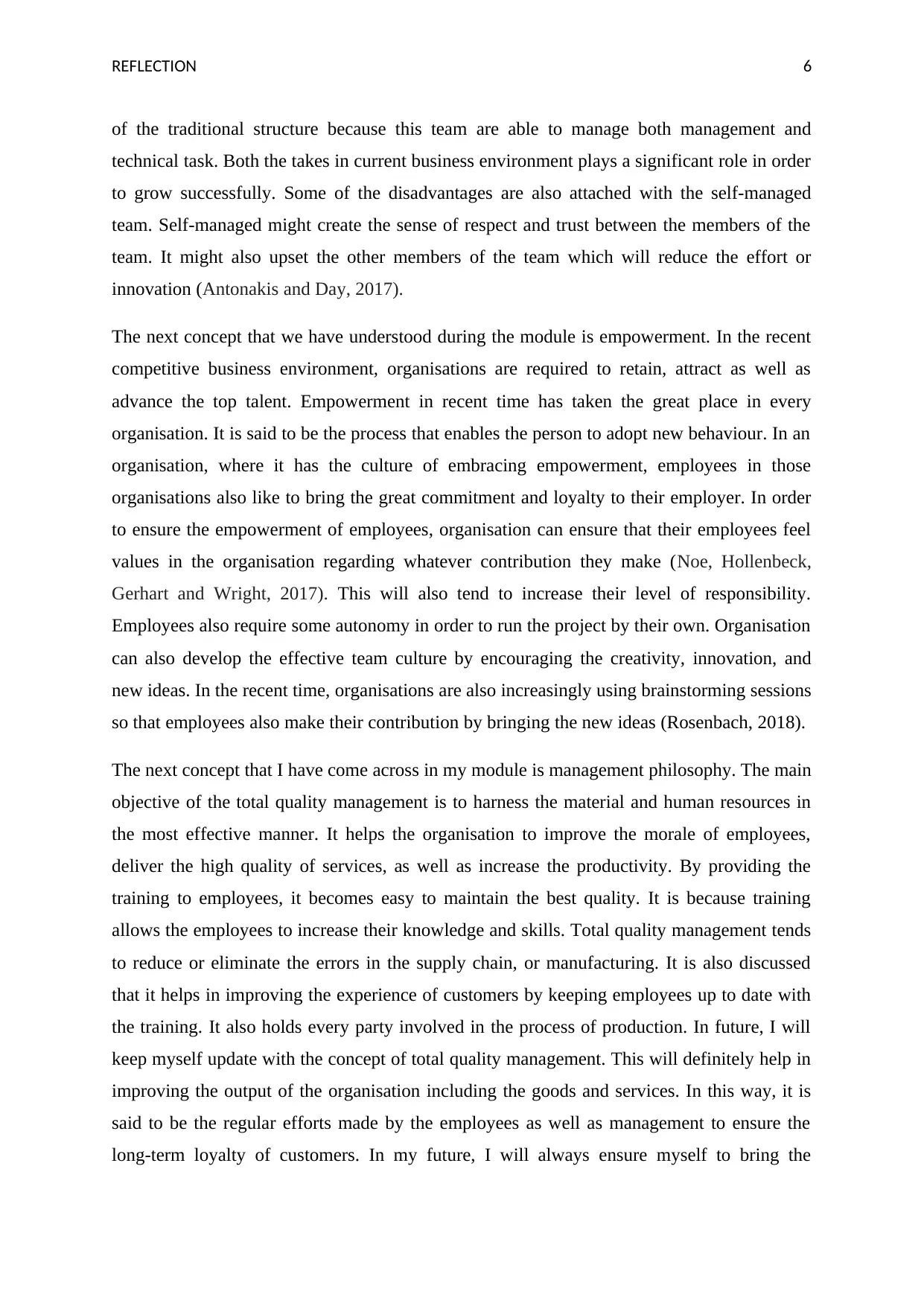
REFLECTION 6
of the traditional structure because this team are able to manage both management and
technical task. Both the takes in current business environment plays a significant role in order
to grow successfully. Some of the disadvantages are also attached with the self-managed
team. Self-managed might create the sense of respect and trust between the members of the
team. It might also upset the other members of the team which will reduce the effort or
innovation (Antonakis and Day, 2017).
The next concept that we have understood during the module is empowerment. In the recent
competitive business environment, organisations are required to retain, attract as well as
advance the top talent. Empowerment in recent time has taken the great place in every
organisation. It is said to be the process that enables the person to adopt new behaviour. In an
organisation, where it has the culture of embracing empowerment, employees in those
organisations also like to bring the great commitment and loyalty to their employer. In order
to ensure the empowerment of employees, organisation can ensure that their employees feel
values in the organisation regarding whatever contribution they make (Noe, Hollenbeck,
Gerhart and Wright, 2017). This will also tend to increase their level of responsibility.
Employees also require some autonomy in order to run the project by their own. Organisation
can also develop the effective team culture by encouraging the creativity, innovation, and
new ideas. In the recent time, organisations are also increasingly using brainstorming sessions
so that employees also make their contribution by bringing the new ideas (Rosenbach, 2018).
The next concept that I have come across in my module is management philosophy. The main
objective of the total quality management is to harness the material and human resources in
the most effective manner. It helps the organisation to improve the morale of employees,
deliver the high quality of services, as well as increase the productivity. By providing the
training to employees, it becomes easy to maintain the best quality. It is because training
allows the employees to increase their knowledge and skills. Total quality management tends
to reduce or eliminate the errors in the supply chain, or manufacturing. It is also discussed
that it helps in improving the experience of customers by keeping employees up to date with
the training. It also holds every party involved in the process of production. In future, I will
keep myself update with the concept of total quality management. This will definitely help in
improving the output of the organisation including the goods and services. In this way, it is
said to be the regular efforts made by the employees as well as management to ensure the
long-term loyalty of customers. In my future, I will always ensure myself to bring the
of the traditional structure because this team are able to manage both management and
technical task. Both the takes in current business environment plays a significant role in order
to grow successfully. Some of the disadvantages are also attached with the self-managed
team. Self-managed might create the sense of respect and trust between the members of the
team. It might also upset the other members of the team which will reduce the effort or
innovation (Antonakis and Day, 2017).
The next concept that we have understood during the module is empowerment. In the recent
competitive business environment, organisations are required to retain, attract as well as
advance the top talent. Empowerment in recent time has taken the great place in every
organisation. It is said to be the process that enables the person to adopt new behaviour. In an
organisation, where it has the culture of embracing empowerment, employees in those
organisations also like to bring the great commitment and loyalty to their employer. In order
to ensure the empowerment of employees, organisation can ensure that their employees feel
values in the organisation regarding whatever contribution they make (Noe, Hollenbeck,
Gerhart and Wright, 2017). This will also tend to increase their level of responsibility.
Employees also require some autonomy in order to run the project by their own. Organisation
can also develop the effective team culture by encouraging the creativity, innovation, and
new ideas. In the recent time, organisations are also increasingly using brainstorming sessions
so that employees also make their contribution by bringing the new ideas (Rosenbach, 2018).
The next concept that I have come across in my module is management philosophy. The main
objective of the total quality management is to harness the material and human resources in
the most effective manner. It helps the organisation to improve the morale of employees,
deliver the high quality of services, as well as increase the productivity. By providing the
training to employees, it becomes easy to maintain the best quality. It is because training
allows the employees to increase their knowledge and skills. Total quality management tends
to reduce or eliminate the errors in the supply chain, or manufacturing. It is also discussed
that it helps in improving the experience of customers by keeping employees up to date with
the training. It also holds every party involved in the process of production. In future, I will
keep myself update with the concept of total quality management. This will definitely help in
improving the output of the organisation including the goods and services. In this way, it is
said to be the regular efforts made by the employees as well as management to ensure the
long-term loyalty of customers. In my future, I will always ensure myself to bring the
Paraphrase This Document
Need a fresh take? Get an instant paraphrase of this document with our AI Paraphraser
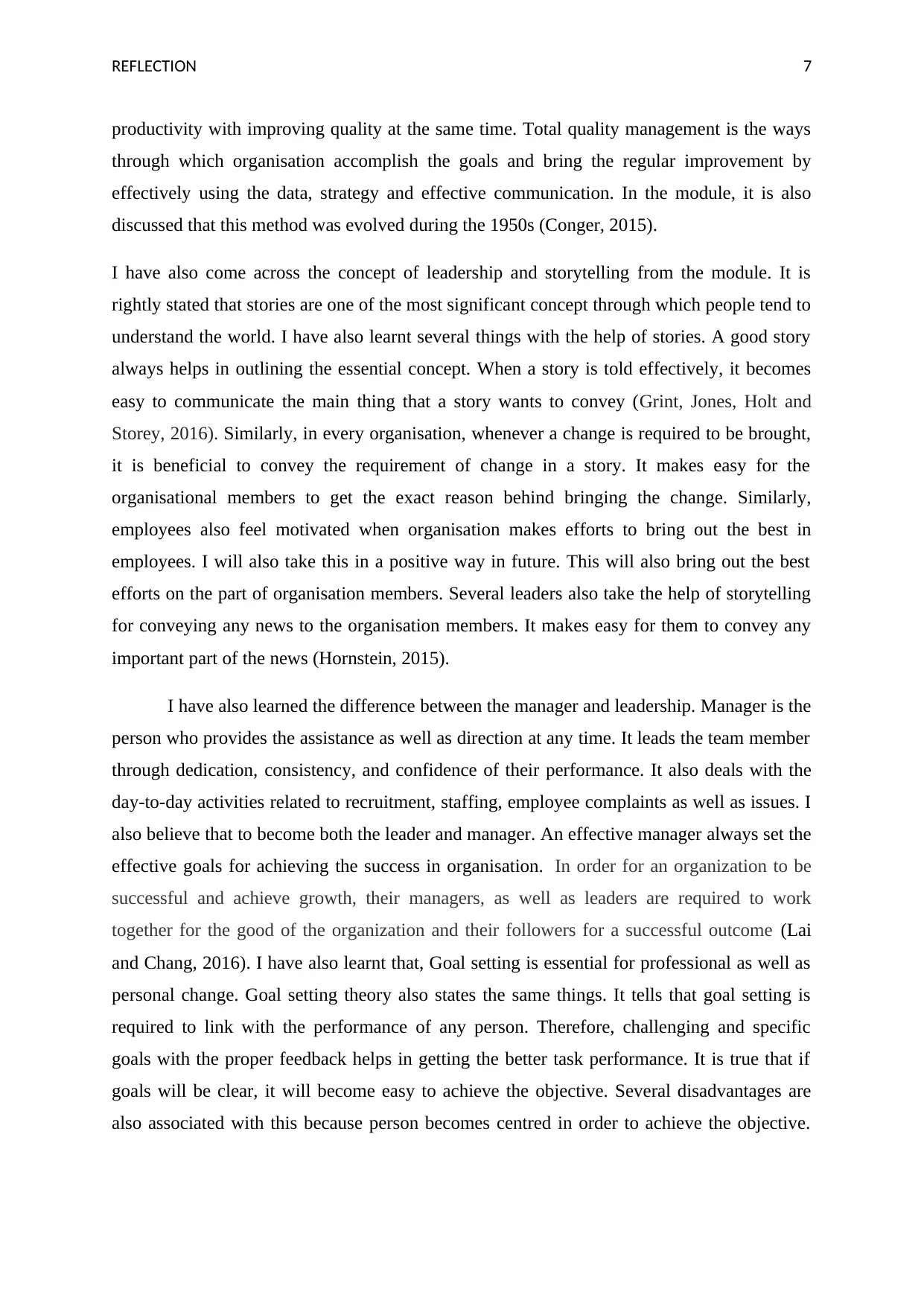
REFLECTION 7
productivity with improving quality at the same time. Total quality management is the ways
through which organisation accomplish the goals and bring the regular improvement by
effectively using the data, strategy and effective communication. In the module, it is also
discussed that this method was evolved during the 1950s (Conger, 2015).
I have also come across the concept of leadership and storytelling from the module. It is
rightly stated that stories are one of the most significant concept through which people tend to
understand the world. I have also learnt several things with the help of stories. A good story
always helps in outlining the essential concept. When a story is told effectively, it becomes
easy to communicate the main thing that a story wants to convey (Grint, Jones, Holt and
Storey, 2016). Similarly, in every organisation, whenever a change is required to be brought,
it is beneficial to convey the requirement of change in a story. It makes easy for the
organisational members to get the exact reason behind bringing the change. Similarly,
employees also feel motivated when organisation makes efforts to bring out the best in
employees. I will also take this in a positive way in future. This will also bring out the best
efforts on the part of organisation members. Several leaders also take the help of storytelling
for conveying any news to the organisation members. It makes easy for them to convey any
important part of the news (Hornstein, 2015).
I have also learned the difference between the manager and leadership. Manager is the
person who provides the assistance as well as direction at any time. It leads the team member
through dedication, consistency, and confidence of their performance. It also deals with the
day-to-day activities related to recruitment, staffing, employee complaints as well as issues. I
also believe that to become both the leader and manager. An effective manager always set the
effective goals for achieving the success in organisation. In order for an organization to be
successful and achieve growth, their managers, as well as leaders are required to work
together for the good of the organization and their followers for a successful outcome (Lai
and Chang, 2016). I have also learnt that, Goal setting is essential for professional as well as
personal change. Goal setting theory also states the same things. It tells that goal setting is
required to link with the performance of any person. Therefore, challenging and specific
goals with the proper feedback helps in getting the better task performance. It is true that if
goals will be clear, it will become easy to achieve the objective. Several disadvantages are
also associated with this because person becomes centred in order to achieve the objective.
productivity with improving quality at the same time. Total quality management is the ways
through which organisation accomplish the goals and bring the regular improvement by
effectively using the data, strategy and effective communication. In the module, it is also
discussed that this method was evolved during the 1950s (Conger, 2015).
I have also come across the concept of leadership and storytelling from the module. It is
rightly stated that stories are one of the most significant concept through which people tend to
understand the world. I have also learnt several things with the help of stories. A good story
always helps in outlining the essential concept. When a story is told effectively, it becomes
easy to communicate the main thing that a story wants to convey (Grint, Jones, Holt and
Storey, 2016). Similarly, in every organisation, whenever a change is required to be brought,
it is beneficial to convey the requirement of change in a story. It makes easy for the
organisational members to get the exact reason behind bringing the change. Similarly,
employees also feel motivated when organisation makes efforts to bring out the best in
employees. I will also take this in a positive way in future. This will also bring out the best
efforts on the part of organisation members. Several leaders also take the help of storytelling
for conveying any news to the organisation members. It makes easy for them to convey any
important part of the news (Hornstein, 2015).
I have also learned the difference between the manager and leadership. Manager is the
person who provides the assistance as well as direction at any time. It leads the team member
through dedication, consistency, and confidence of their performance. It also deals with the
day-to-day activities related to recruitment, staffing, employee complaints as well as issues. I
also believe that to become both the leader and manager. An effective manager always set the
effective goals for achieving the success in organisation. In order for an organization to be
successful and achieve growth, their managers, as well as leaders are required to work
together for the good of the organization and their followers for a successful outcome (Lai
and Chang, 2016). I have also learnt that, Goal setting is essential for professional as well as
personal change. Goal setting theory also states the same things. It tells that goal setting is
required to link with the performance of any person. Therefore, challenging and specific
goals with the proper feedback helps in getting the better task performance. It is true that if
goals will be clear, it will become easy to achieve the objective. Several disadvantages are
also associated with this because person becomes centred in order to achieve the objective.
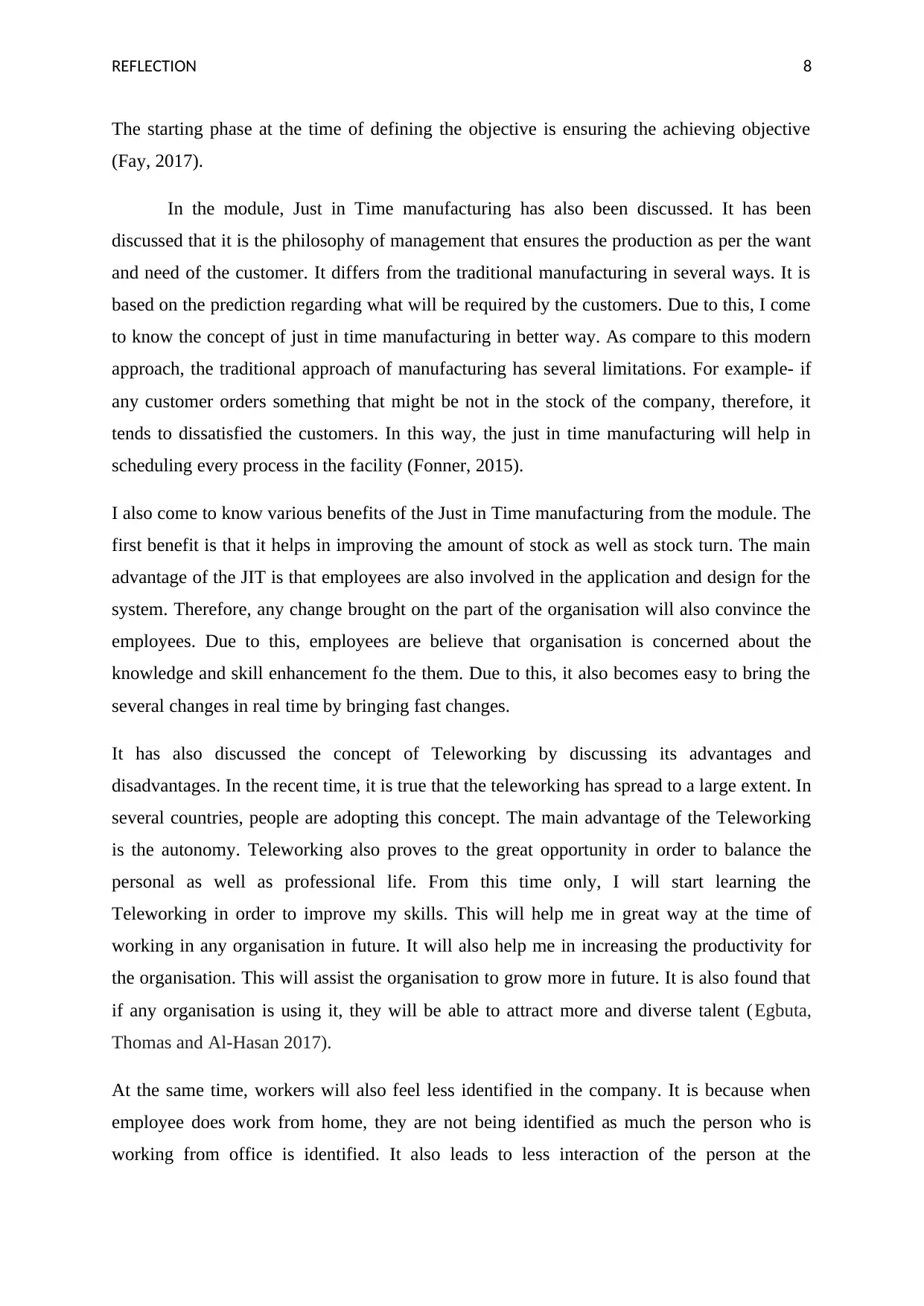
REFLECTION 8
The starting phase at the time of defining the objective is ensuring the achieving objective
(Fay, 2017).
In the module, Just in Time manufacturing has also been discussed. It has been
discussed that it is the philosophy of management that ensures the production as per the want
and need of the customer. It differs from the traditional manufacturing in several ways. It is
based on the prediction regarding what will be required by the customers. Due to this, I come
to know the concept of just in time manufacturing in better way. As compare to this modern
approach, the traditional approach of manufacturing has several limitations. For example- if
any customer orders something that might be not in the stock of the company, therefore, it
tends to dissatisfied the customers. In this way, the just in time manufacturing will help in
scheduling every process in the facility (Fonner, 2015).
I also come to know various benefits of the Just in Time manufacturing from the module. The
first benefit is that it helps in improving the amount of stock as well as stock turn. The main
advantage of the JIT is that employees are also involved in the application and design for the
system. Therefore, any change brought on the part of the organisation will also convince the
employees. Due to this, employees are believe that organisation is concerned about the
knowledge and skill enhancement fo the them. Due to this, it also becomes easy to bring the
several changes in real time by bringing fast changes.
It has also discussed the concept of Teleworking by discussing its advantages and
disadvantages. In the recent time, it is true that the teleworking has spread to a large extent. In
several countries, people are adopting this concept. The main advantage of the Teleworking
is the autonomy. Teleworking also proves to the great opportunity in order to balance the
personal as well as professional life. From this time only, I will start learning the
Teleworking in order to improve my skills. This will help me in great way at the time of
working in any organisation in future. It will also help me in increasing the productivity for
the organisation. This will assist the organisation to grow more in future. It is also found that
if any organisation is using it, they will be able to attract more and diverse talent (Egbuta,
Thomas and Al-Hasan 2017).
At the same time, workers will also feel less identified in the company. It is because when
employee does work from home, they are not being identified as much the person who is
working from office is identified. It also leads to less interaction of the person at the
The starting phase at the time of defining the objective is ensuring the achieving objective
(Fay, 2017).
In the module, Just in Time manufacturing has also been discussed. It has been
discussed that it is the philosophy of management that ensures the production as per the want
and need of the customer. It differs from the traditional manufacturing in several ways. It is
based on the prediction regarding what will be required by the customers. Due to this, I come
to know the concept of just in time manufacturing in better way. As compare to this modern
approach, the traditional approach of manufacturing has several limitations. For example- if
any customer orders something that might be not in the stock of the company, therefore, it
tends to dissatisfied the customers. In this way, the just in time manufacturing will help in
scheduling every process in the facility (Fonner, 2015).
I also come to know various benefits of the Just in Time manufacturing from the module. The
first benefit is that it helps in improving the amount of stock as well as stock turn. The main
advantage of the JIT is that employees are also involved in the application and design for the
system. Therefore, any change brought on the part of the organisation will also convince the
employees. Due to this, employees are believe that organisation is concerned about the
knowledge and skill enhancement fo the them. Due to this, it also becomes easy to bring the
several changes in real time by bringing fast changes.
It has also discussed the concept of Teleworking by discussing its advantages and
disadvantages. In the recent time, it is true that the teleworking has spread to a large extent. In
several countries, people are adopting this concept. The main advantage of the Teleworking
is the autonomy. Teleworking also proves to the great opportunity in order to balance the
personal as well as professional life. From this time only, I will start learning the
Teleworking in order to improve my skills. This will help me in great way at the time of
working in any organisation in future. It will also help me in increasing the productivity for
the organisation. This will assist the organisation to grow more in future. It is also found that
if any organisation is using it, they will be able to attract more and diverse talent (Egbuta,
Thomas and Al-Hasan 2017).
At the same time, workers will also feel less identified in the company. It is because when
employee does work from home, they are not being identified as much the person who is
working from office is identified. It also leads to less interaction of the person at the
⊘ This is a preview!⊘
Do you want full access?
Subscribe today to unlock all pages.

Trusted by 1+ million students worldwide
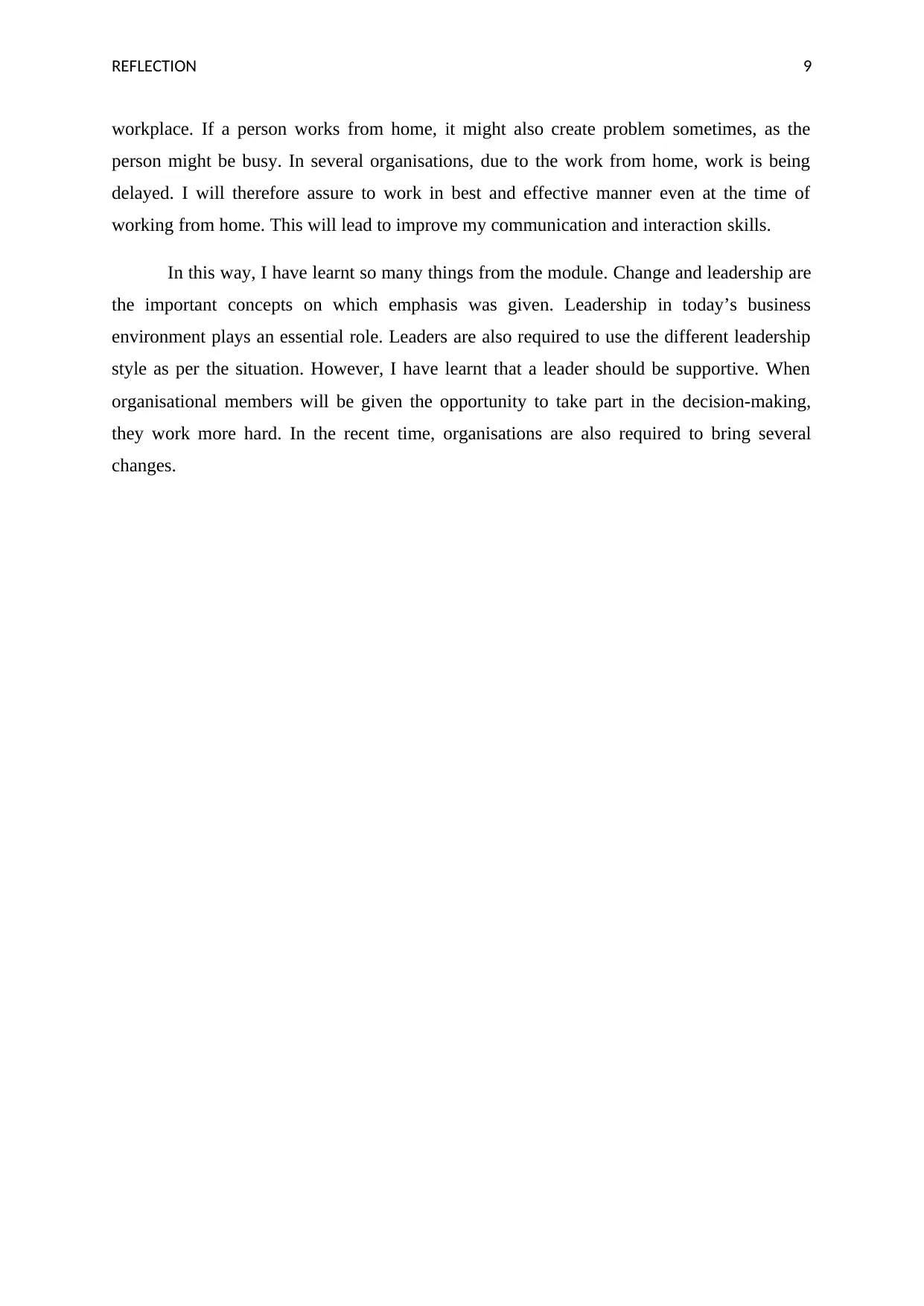
REFLECTION 9
workplace. If a person works from home, it might also create problem sometimes, as the
person might be busy. In several organisations, due to the work from home, work is being
delayed. I will therefore assure to work in best and effective manner even at the time of
working from home. This will lead to improve my communication and interaction skills.
In this way, I have learnt so many things from the module. Change and leadership are
the important concepts on which emphasis was given. Leadership in today’s business
environment plays an essential role. Leaders are also required to use the different leadership
style as per the situation. However, I have learnt that a leader should be supportive. When
organisational members will be given the opportunity to take part in the decision-making,
they work more hard. In the recent time, organisations are also required to bring several
changes.
workplace. If a person works from home, it might also create problem sometimes, as the
person might be busy. In several organisations, due to the work from home, work is being
delayed. I will therefore assure to work in best and effective manner even at the time of
working from home. This will lead to improve my communication and interaction skills.
In this way, I have learnt so many things from the module. Change and leadership are
the important concepts on which emphasis was given. Leadership in today’s business
environment plays an essential role. Leaders are also required to use the different leadership
style as per the situation. However, I have learnt that a leader should be supportive. When
organisational members will be given the opportunity to take part in the decision-making,
they work more hard. In the recent time, organisations are also required to bring several
changes.
Paraphrase This Document
Need a fresh take? Get an instant paraphrase of this document with our AI Paraphraser
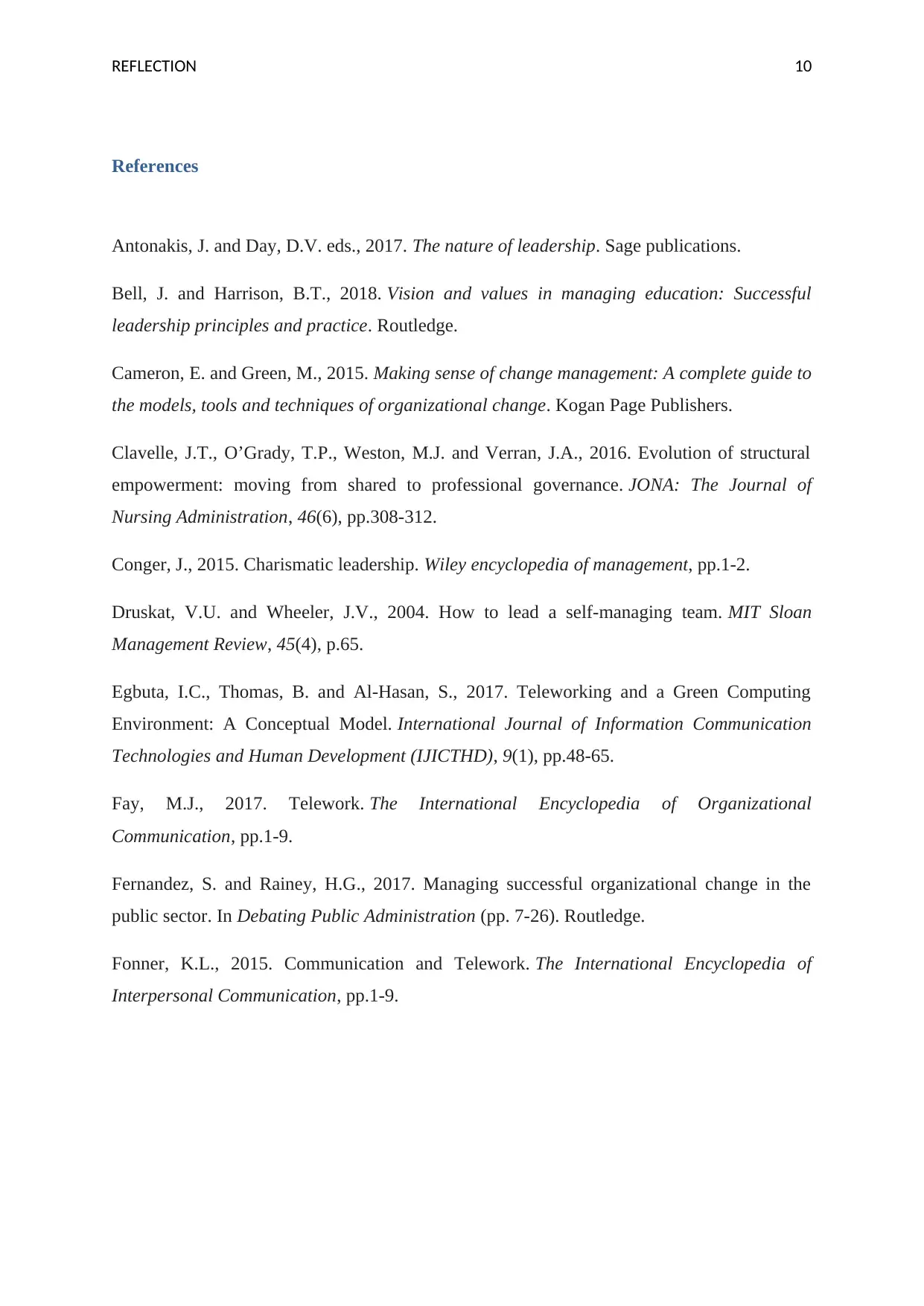
REFLECTION 10
References
Antonakis, J. and Day, D.V. eds., 2017. The nature of leadership. Sage publications.
Bell, J. and Harrison, B.T., 2018. Vision and values in managing education: Successful
leadership principles and practice. Routledge.
Cameron, E. and Green, M., 2015. Making sense of change management: A complete guide to
the models, tools and techniques of organizational change. Kogan Page Publishers.
Clavelle, J.T., O’Grady, T.P., Weston, M.J. and Verran, J.A., 2016. Evolution of structural
empowerment: moving from shared to professional governance. JONA: The Journal of
Nursing Administration, 46(6), pp.308-312.
Conger, J., 2015. Charismatic leadership. Wiley encyclopedia of management, pp.1-2.
Druskat, V.U. and Wheeler, J.V., 2004. How to lead a self-managing team. MIT Sloan
Management Review, 45(4), p.65.
Egbuta, I.C., Thomas, B. and Al-Hasan, S., 2017. Teleworking and a Green Computing
Environment: A Conceptual Model. International Journal of Information Communication
Technologies and Human Development (IJICTHD), 9(1), pp.48-65.
Fay, M.J., 2017. Telework. The International Encyclopedia of Organizational
Communication, pp.1-9.
Fernandez, S. and Rainey, H.G., 2017. Managing successful organizational change in the
public sector. In Debating Public Administration (pp. 7-26). Routledge.
Fonner, K.L., 2015. Communication and Telework. The International Encyclopedia of
Interpersonal Communication, pp.1-9.
References
Antonakis, J. and Day, D.V. eds., 2017. The nature of leadership. Sage publications.
Bell, J. and Harrison, B.T., 2018. Vision and values in managing education: Successful
leadership principles and practice. Routledge.
Cameron, E. and Green, M., 2015. Making sense of change management: A complete guide to
the models, tools and techniques of organizational change. Kogan Page Publishers.
Clavelle, J.T., O’Grady, T.P., Weston, M.J. and Verran, J.A., 2016. Evolution of structural
empowerment: moving from shared to professional governance. JONA: The Journal of
Nursing Administration, 46(6), pp.308-312.
Conger, J., 2015. Charismatic leadership. Wiley encyclopedia of management, pp.1-2.
Druskat, V.U. and Wheeler, J.V., 2004. How to lead a self-managing team. MIT Sloan
Management Review, 45(4), p.65.
Egbuta, I.C., Thomas, B. and Al-Hasan, S., 2017. Teleworking and a Green Computing
Environment: A Conceptual Model. International Journal of Information Communication
Technologies and Human Development (IJICTHD), 9(1), pp.48-65.
Fay, M.J., 2017. Telework. The International Encyclopedia of Organizational
Communication, pp.1-9.
Fernandez, S. and Rainey, H.G., 2017. Managing successful organizational change in the
public sector. In Debating Public Administration (pp. 7-26). Routledge.
Fonner, K.L., 2015. Communication and Telework. The International Encyclopedia of
Interpersonal Communication, pp.1-9.
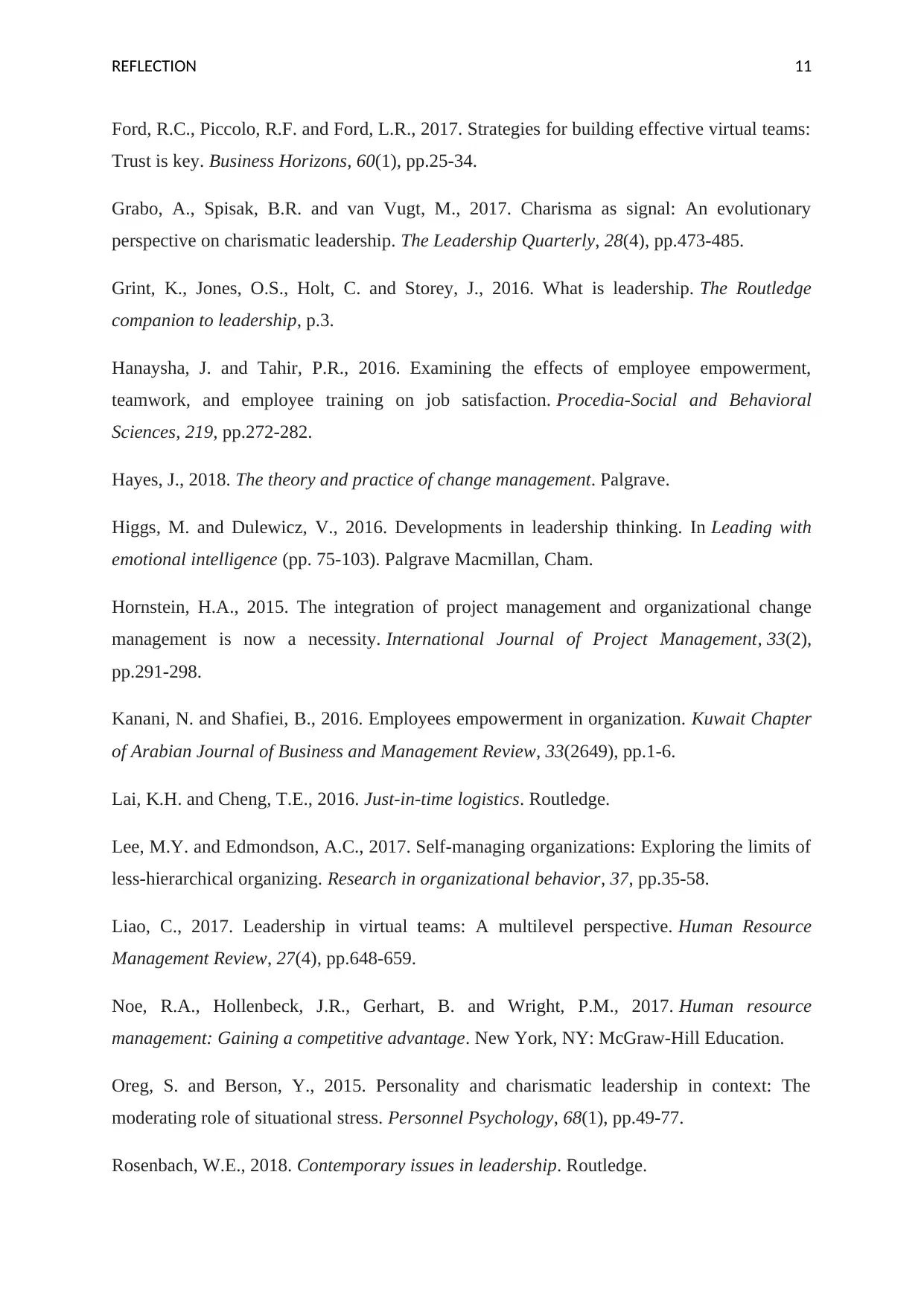
REFLECTION 11
Ford, R.C., Piccolo, R.F. and Ford, L.R., 2017. Strategies for building effective virtual teams:
Trust is key. Business Horizons, 60(1), pp.25-34.
Grabo, A., Spisak, B.R. and van Vugt, M., 2017. Charisma as signal: An evolutionary
perspective on charismatic leadership. The Leadership Quarterly, 28(4), pp.473-485.
Grint, K., Jones, O.S., Holt, C. and Storey, J., 2016. What is leadership. The Routledge
companion to leadership, p.3.
Hanaysha, J. and Tahir, P.R., 2016. Examining the effects of employee empowerment,
teamwork, and employee training on job satisfaction. Procedia-Social and Behavioral
Sciences, 219, pp.272-282.
Hayes, J., 2018. The theory and practice of change management. Palgrave.
Higgs, M. and Dulewicz, V., 2016. Developments in leadership thinking. In Leading with
emotional intelligence (pp. 75-103). Palgrave Macmillan, Cham.
Hornstein, H.A., 2015. The integration of project management and organizational change
management is now a necessity. International Journal of Project Management, 33(2),
pp.291-298.
Kanani, N. and Shafiei, B., 2016. Employees empowerment in organization. Kuwait Chapter
of Arabian Journal of Business and Management Review, 33(2649), pp.1-6.
Lai, K.H. and Cheng, T.E., 2016. Just-in-time logistics. Routledge.
Lee, M.Y. and Edmondson, A.C., 2017. Self-managing organizations: Exploring the limits of
less-hierarchical organizing. Research in organizational behavior, 37, pp.35-58.
Liao, C., 2017. Leadership in virtual teams: A multilevel perspective. Human Resource
Management Review, 27(4), pp.648-659.
Noe, R.A., Hollenbeck, J.R., Gerhart, B. and Wright, P.M., 2017. Human resource
management: Gaining a competitive advantage. New York, NY: McGraw-Hill Education.
Oreg, S. and Berson, Y., 2015. Personality and charismatic leadership in context: The
moderating role of situational stress. Personnel Psychology, 68(1), pp.49-77.
Rosenbach, W.E., 2018. Contemporary issues in leadership. Routledge.
Ford, R.C., Piccolo, R.F. and Ford, L.R., 2017. Strategies for building effective virtual teams:
Trust is key. Business Horizons, 60(1), pp.25-34.
Grabo, A., Spisak, B.R. and van Vugt, M., 2017. Charisma as signal: An evolutionary
perspective on charismatic leadership. The Leadership Quarterly, 28(4), pp.473-485.
Grint, K., Jones, O.S., Holt, C. and Storey, J., 2016. What is leadership. The Routledge
companion to leadership, p.3.
Hanaysha, J. and Tahir, P.R., 2016. Examining the effects of employee empowerment,
teamwork, and employee training on job satisfaction. Procedia-Social and Behavioral
Sciences, 219, pp.272-282.
Hayes, J., 2018. The theory and practice of change management. Palgrave.
Higgs, M. and Dulewicz, V., 2016. Developments in leadership thinking. In Leading with
emotional intelligence (pp. 75-103). Palgrave Macmillan, Cham.
Hornstein, H.A., 2015. The integration of project management and organizational change
management is now a necessity. International Journal of Project Management, 33(2),
pp.291-298.
Kanani, N. and Shafiei, B., 2016. Employees empowerment in organization. Kuwait Chapter
of Arabian Journal of Business and Management Review, 33(2649), pp.1-6.
Lai, K.H. and Cheng, T.E., 2016. Just-in-time logistics. Routledge.
Lee, M.Y. and Edmondson, A.C., 2017. Self-managing organizations: Exploring the limits of
less-hierarchical organizing. Research in organizational behavior, 37, pp.35-58.
Liao, C., 2017. Leadership in virtual teams: A multilevel perspective. Human Resource
Management Review, 27(4), pp.648-659.
Noe, R.A., Hollenbeck, J.R., Gerhart, B. and Wright, P.M., 2017. Human resource
management: Gaining a competitive advantage. New York, NY: McGraw-Hill Education.
Oreg, S. and Berson, Y., 2015. Personality and charismatic leadership in context: The
moderating role of situational stress. Personnel Psychology, 68(1), pp.49-77.
Rosenbach, W.E., 2018. Contemporary issues in leadership. Routledge.
⊘ This is a preview!⊘
Do you want full access?
Subscribe today to unlock all pages.

Trusted by 1+ million students worldwide
1 out of 13
Related Documents
Your All-in-One AI-Powered Toolkit for Academic Success.
+13062052269
info@desklib.com
Available 24*7 on WhatsApp / Email
![[object Object]](/_next/static/media/star-bottom.7253800d.svg)
Unlock your academic potential
Copyright © 2020–2025 A2Z Services. All Rights Reserved. Developed and managed by ZUCOL.





